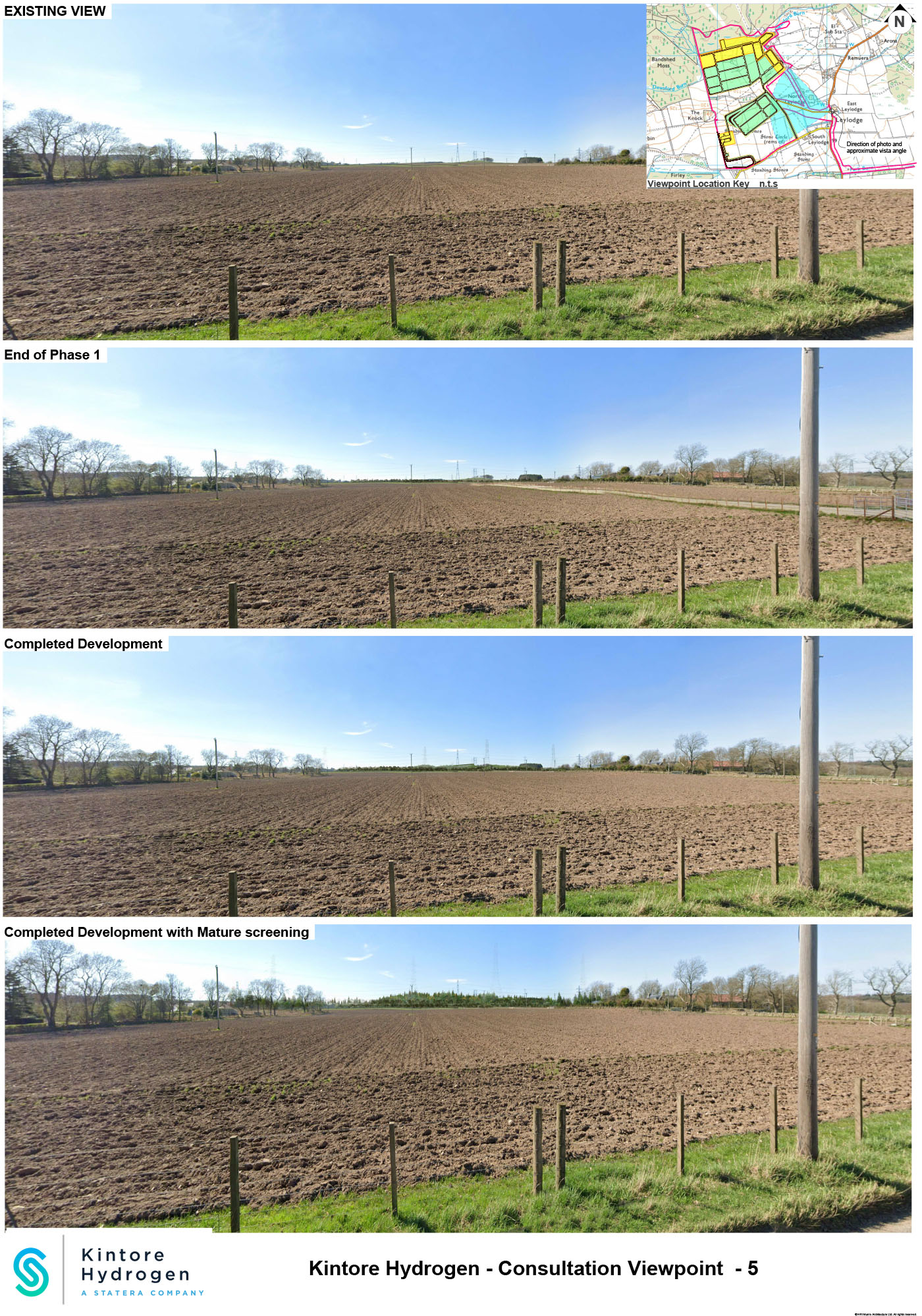Public consultation event
Event two - June 2024

Who we are
About Statera
We develop energy infrastructure to balance a high renewables electricity system. This includes battery storage, pumped storage hydro, flexible generation plants, and green hydrogen projects.
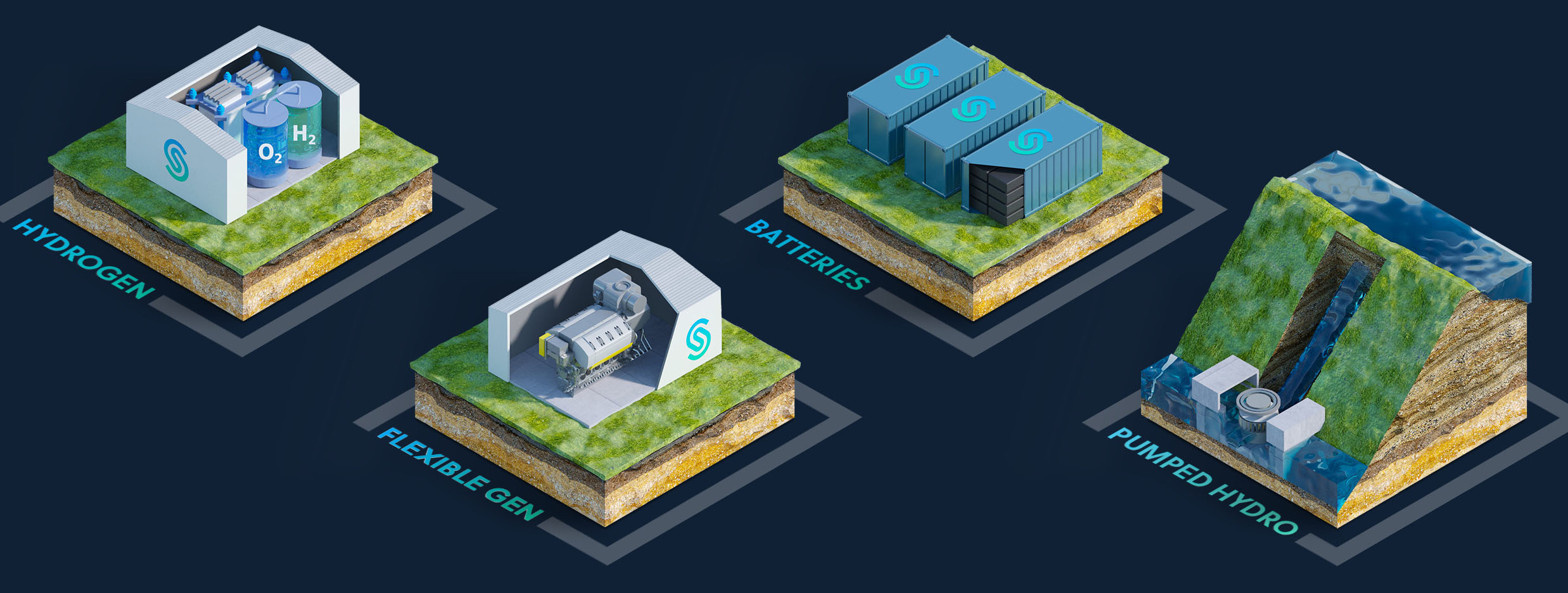
Our technologies ensure a reliable energy supply
As we increasingly rely on renewable sources of energy - like solar and wind - there are periods of extended shortfall and excess of energy production. Statera's infrastructure provides the storage capacity and flexibility that the grid needs to ensure we can keep the lights on when the sun is not shining and the wind is not blowing.
By facilitating the shift to a renewables-led energy system, these technologies are helping lower carbon emissions at the best value for energy users across the UK.
In Scotland, there is a compelling role for hydrogen production via electrolysis at sites such as Kintore Hydrogen to assist with this grid balancing and decarbonisation.
What's the purpose of this exhibition?
-

View our updated proposals for Kintore Hydrogen based on feedback from our 24th April event
-

Obtain feedback to help inform proposals prior to planning submission
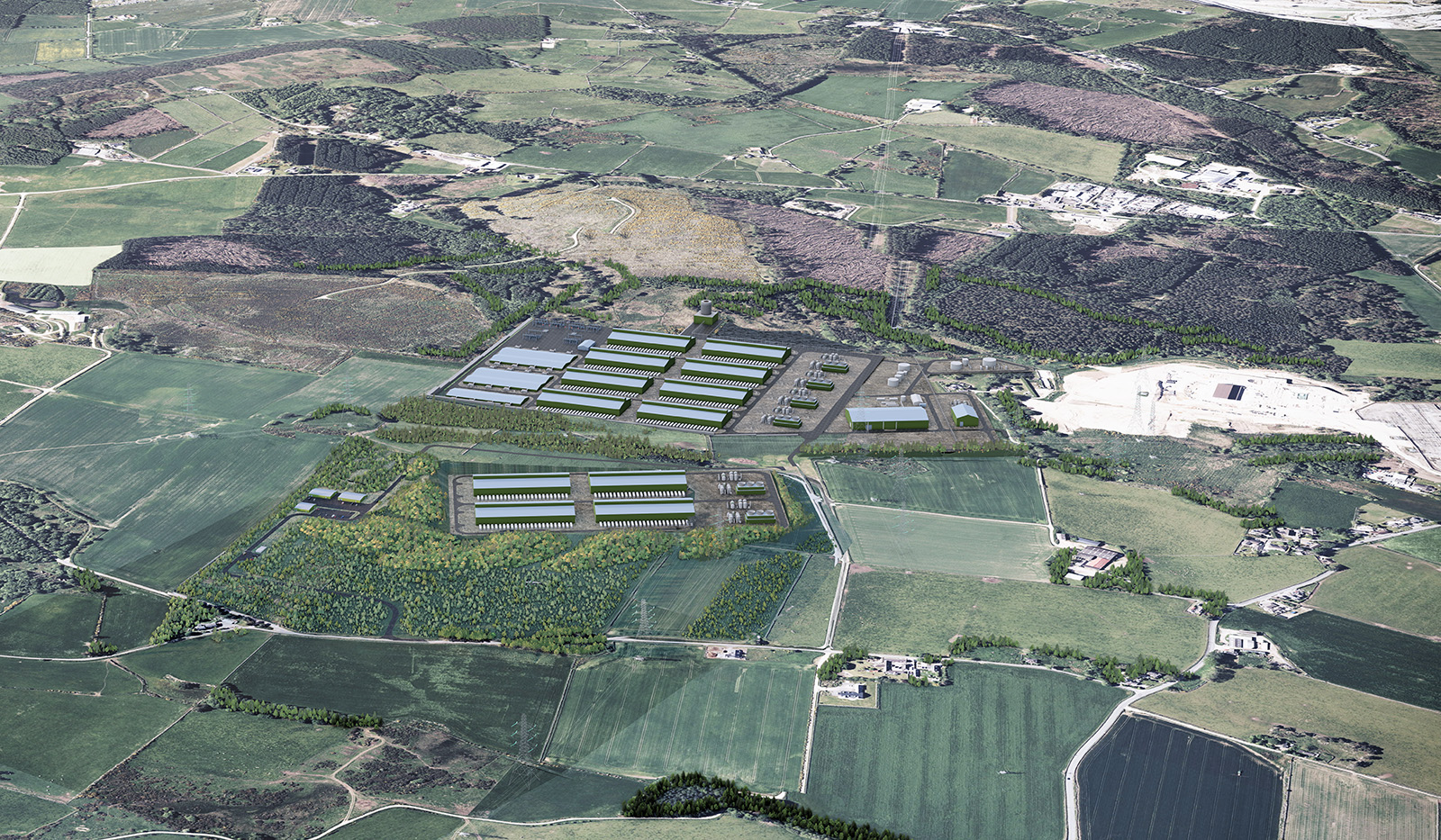

Why is this project needed?
Both the UK and Scottish Governments are committed to hydrogen as a key element of our energy future. In addition the Scottish Government has targeted a five fold increase in offshore wind energy generation by 2030, to shift the energy system to being renewables-led. This growth is underway with the Scotwind leasing programme supporting up to 28GW of offshore wind projects in the coming years.
National need
At full capacity, the amount of energy generated off the shores of Scotland will far exceed local demand, creating an opportunity to supply that energy to users across Great Britain. The North East's future economy could be significantly underpinned by investment in offshore wind - but at the moment this investment is constrained. This is because the national electricity grid that sends the wind energy across the country requires a transformational upgrade, which is not easy to achieve quickly - it will take significant time and money.
To mitigate this and as an alternative to transmission infrastructure (e.g. pylons), Kintore Hydrogen can take electricity produced by wind offshore of Scotland and turn it into hydrogen, which can then be sent safely through National Gas' network of transmission pipelines across the country to areas urgently needing to decarbonise, such as power generation facilities and energy intensive industrial clusters. Users will be able to transition away from high-carbon natural gas to green hydrogen.
Kintore Hydrogen would make a material contribution to the ambitious hydrogen production targets for the 2030s and beyond to which the governments in both Scotland (5GW by 2030) and Westminster (10GW by 2030) have committed themselves. Scotland alone has a 25GW low carbon hydrogen production target for 2045.
Why here
-

an appropriate electrical connection to a substation
-

a connection to the gas network via the National Transmission System (NTS) to move the hydrogen we produce
-

a plentiful supply of fresh non-drinking water (the River Don)


Understanding the technology
01. Electrolysis process
Water is abstracted from the River Don and piped to the main site for the purposes of producing hydrogen and cooling the plant. Before any water goes through the electrolysers, it must be purified (by removing sediments and minerals) and de-ionised. By applying electricity to the purified water, oxygen and hydrogen molecules will separate. The hydrogen will be further purified, dehydrated and compressed to enable it to be piped to the National Transmission System (NTS), before being injected there and made available to gas customers. Initially, the hydrogen will be blended with existing natural gas. In the longer-term it will be exported using National Gas' proposed 100% hydrogen network which is likely to run via our site and is proposed to come online in around 2030.
02. Hydrogen storage
Hydrogen will not be stored at the site. Designers are also instructed to minimise the quantities of hydrogen contained within the pipework and equipment located at the site, as well as eliminating sources of ignition to create a safe and operable plant for decades.
03. Scale
At 3GW, the plant would be one of the largest and most sophisticated in the world. The project is being built on this scale to enable green hydrogen to be produced at lowest cost to consumers. Building at such scale will establish the North East of Scotland at the heart of this developing global industry. The natural contours of the site and proposed earthworks for any development in areas that are currently more visible mean that the aim is for the site to be substantially screened from view.
04. Carbon saving
Kintore Hydrogen will make a very real contribution to reducing carbon emissions. Heavy, heat-intensive industries such as steel, glass and cement making are currently reliant on burning fossil fuels and in the process release large amounts of carbon. Kintore Hydrogen will produce hydrogen than can enable these industries to thrive whilst reducing dependence on fossil fuels. 1kg of Hydrogen contains 2.6 times the heat content of 1kg of natural gas. Every time 1kg of hydrogen is used instead of an equivalent amount of natural gas for heating, 7kg of CO2 emissions are avoided.
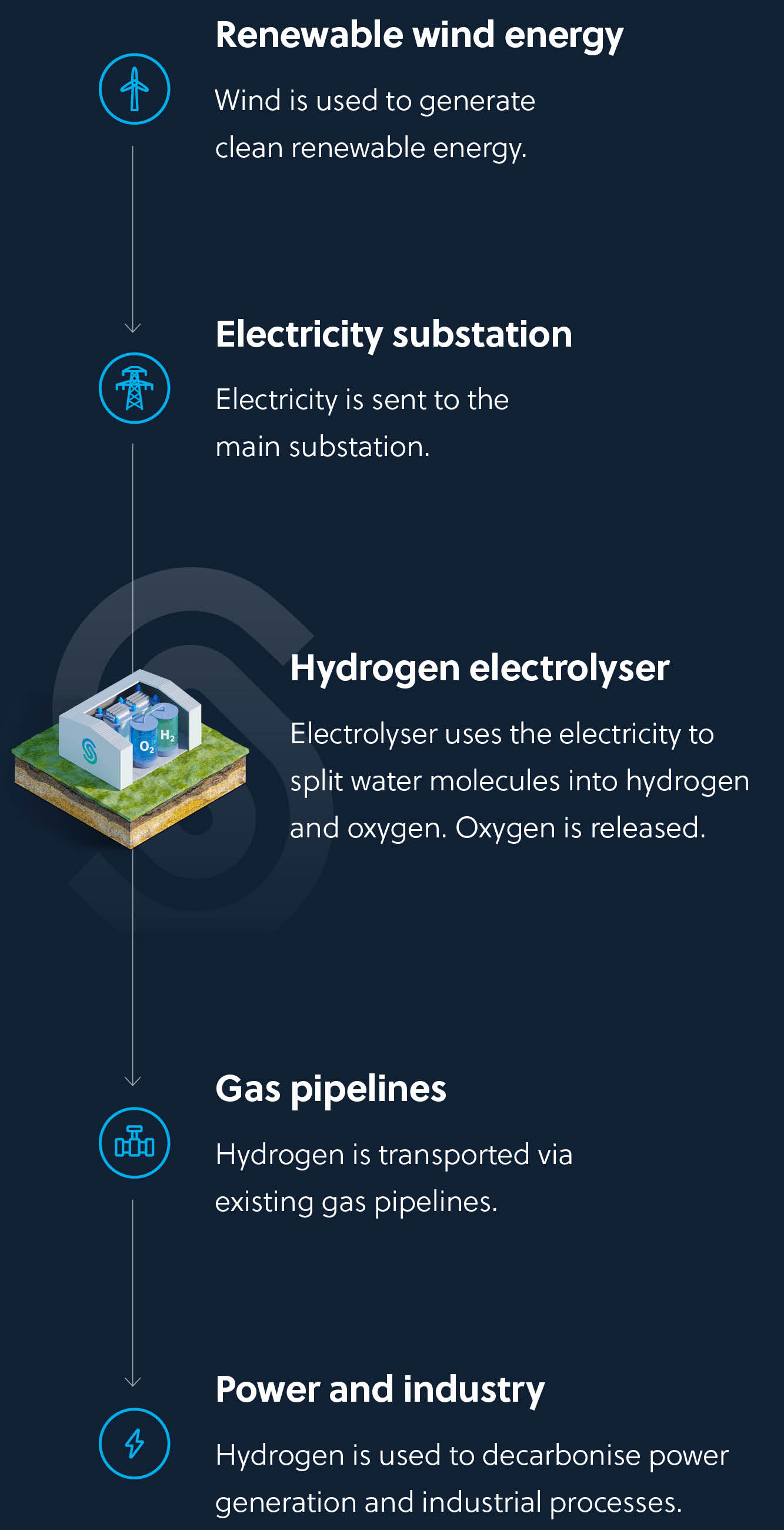


Indicative design
Main site
- 1. Grid connection
- 2. Electrical substation facilities (AIS and GIS)
- 3. Electrolyser enclosures and associated infrastructure
- 4. Cooling facilities
- 5. Hydrogen and water treatment facilities
- 6. Hydrogen compression enclosures
- 7. Flaring infrastructure (i.e. enclosed ground flare)
- 8. H2 pipeline
- 9. Office, workshop and parking
- 10. Pipeline Inspection Gauge (PIG) facilities

Masterplans are indicative of how infrastructure could be laid out within the redline in accordance with parameters to be included within our application for planning permission in principle (PPiP). As per the planning process information board, the detailed design and layout of all infrastructure following any grant of PPiP would be subject to applications for matters specified in conditions.

Indicative design
Gas and water
Gas connection
Gas connection infrastructure at Womblehill to enable hydrogen injection into the National Transmission System for Gas (NTS). Access will be taken off the B977 to the north.
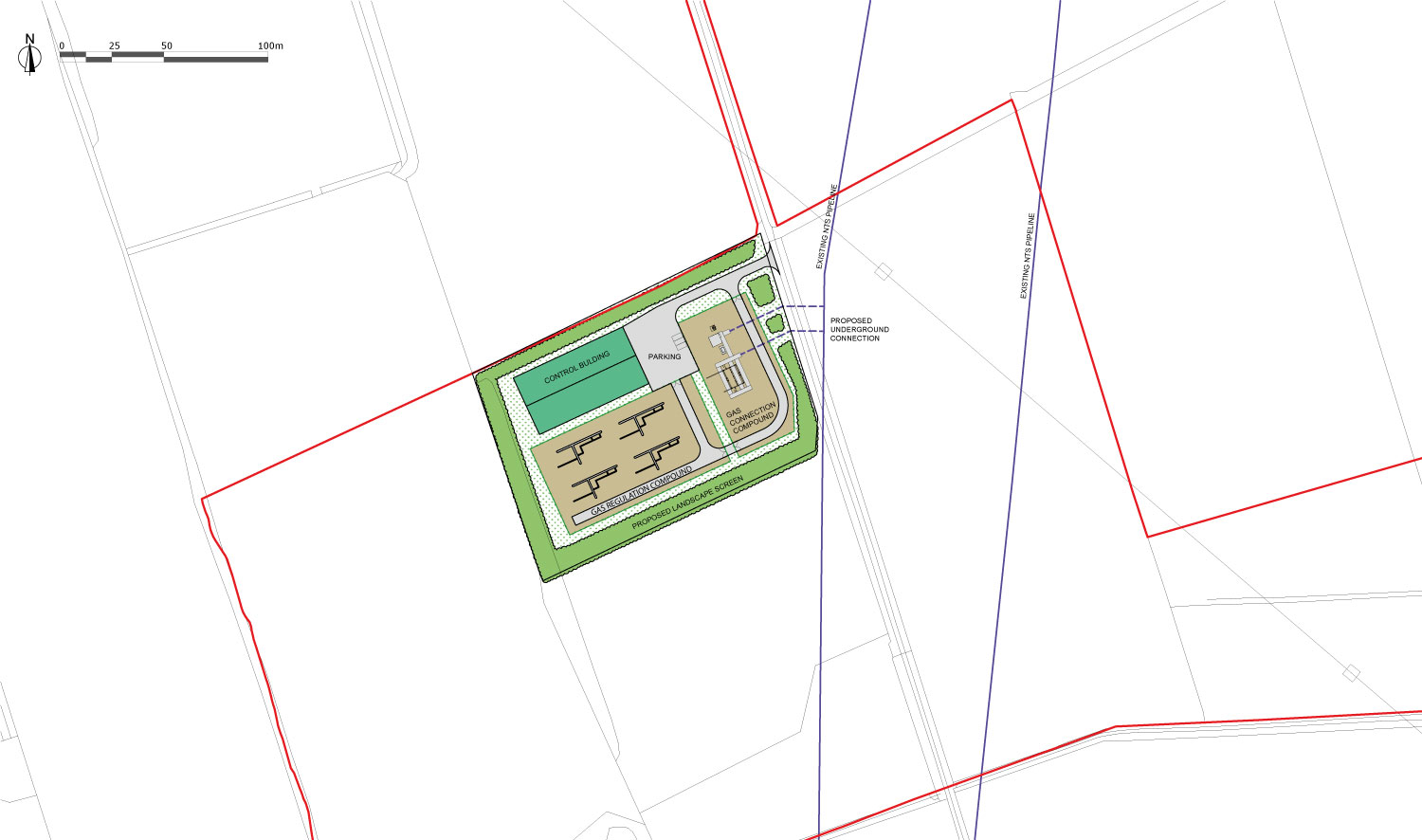
Water abstraction
Abstraction infrastructure by the River Don will include a pump house south of the railway with pipes running to the abstraction point within the bank and bed of the River Don.
We are also exploring the option of siting water treatment facilities here rather than at the main site. Any buildings at this location would be agricultural style barn buildings to better blend into the landscape.

Masterplans are indicative of how infrastructure could be laid out within the redline in accordance with parameters to be included within our application for planning permission in principle (PPiP). As per the planning process information board, the detailed design and layout of all infrastructure following any grant of PPiP would be subject to applications for matters specified in conditions.

Environmental considerations
We want to be part of Scotland's and the UK's transition to net zero greenhouse gas emissions and combating climate change. We understand that priorities for local communities will include managing temporary traffic and noise during construction, and good design to minimise intrusion into the landscape. We also understand that soil, water quality and natural habitats should be protected and, where possible, enhanced.
Environmental studies
Our application will include an Environmental Impact Assessment (EIA). It will explain how Kintore Hydrogen could affect the environment and how harmful effects will be avoided through design or controlled and reduced to a level that is environmentally acceptable.
At the end of 2023, we consulted Aberdeenshire Council and environmental stakeholders such as the Scottish Environment Protection Agency (SEPA), NatureScot and Historic Environment Scotland to receive guidance on what the EIA should cover, which they have fed back to us in the EIA Scoping Opinion (published on the Council's planning website). We are conducting various surveys, including current noise and traffic levels around the site, water and soil sampling, and recording existing habitats and species, to inform our assessments.
Environmental gain
Beyond environmental protection, our goal is to provide environmental gain. Opportunities include creation of new areas of riparian habitat on the banks of the River Don and working with the River Don Trust to look at other ways the Don's environmental status and fishing could be benefited. Elsewhere, planting will form part of the design, which will include providing bat and bird boxes, insect habitat and reptile refugia. We would welcome feedback about other environmental improvement opportunities in the local area.
The existing environment
The site is predominantly farmland with limited natural habitat. Stands of trees, hedges and the wetter habitat north of the Dewsford Burn at the top of the site have more value for wildlife.
Species recorded in and near the site include likely roosting bats, badgers, sand martin and raptors, and signs of pine marten and red squirrel. There are no protected wildlife sites within or nearby the site. An ancient standing stone in the south east of the main site is a protected Scheduled Monument. The site is not within a flood risk zone and is drained by a number of burns, all in the River Don catchment.
Some of our emerging design goals so far are to:
- protect and enhance the areas in the north of the site which have higher habitat value
- lay out buildings to best use the main site's central ridgeline and woodland to minimise the development's visibility
- retain the standing stone Scheduled Monument
- ensure the drainage design causes no increase in flood risk.
Beyond the main site, pipeline routes for water intake/discharge and hydrogen export will cross farmland, watercourses and roads. Trenching to lay the pipelines will avoid areas with higher ecology value or will use ‘trenchless’ construction to avoid disturbance. After the pipelines have been laid, the land above would be returned to agricultural use.
We have been granted an abstraction licence for the River Don. This controls the amount of water that can be taken and returned to the river. Around a third of the river water taken from the Don will be returned to it, with the other two-thirds being used on site.

Construction and operation
Statera has a wealth of experience across the UK in how to do construction right. This includes close liaison with the community, working within site constraints and construction controls, and live monitoring of our construction works and effects.
During construction
During construction, and in order to achieve a safe construction access that complies with Aberdeenshire Council standards, a new temporary access is required off the B977 at location A indicated on the plan.
We recognise that construction phase arrangements are particularly sensitive for local residents. To minimise disruption during the construction process, we will implement various measures including:
- Curtailment of construction traffic during peak periods, with subcontractors contractually obliged to avoid peak periods on the B977
- No queuing, parking or unloading on the B977 or any public highway
- A delivery/booking schedule agreed weekly with contractors to control the timing and number of construction deliveries to site
- An HGV holding area on the main site (away from the B977) to be constructed and manned to limit the number of HGVs leaving the site simultaneously
- Offsite parking for construction workers, with passenger carrying vehicles (e.g. bus/minibus) used to transport workers to site
- Mandate lower speeds to HGVs coming to site so that they travel slower than the current 40mph limit on the B977.
Ongoing communication
We will proactively communicate with local residents throughout our construction phase, with the existing community liaison structures continuing, the project website being regularly updated and a 24 hour help line set up to receive queries from the public.
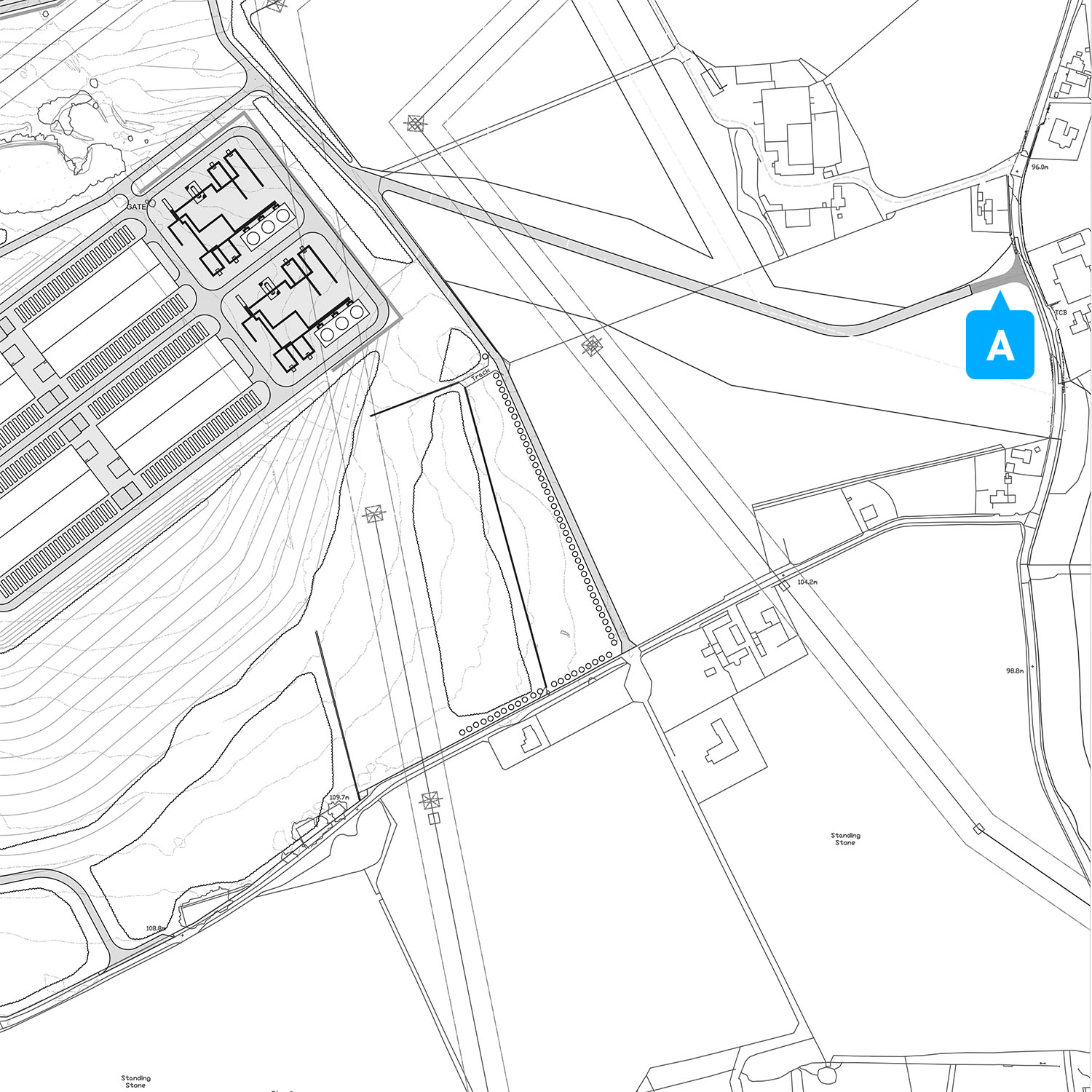
See below for a plan showing the construction routing for each element of the redline boundary
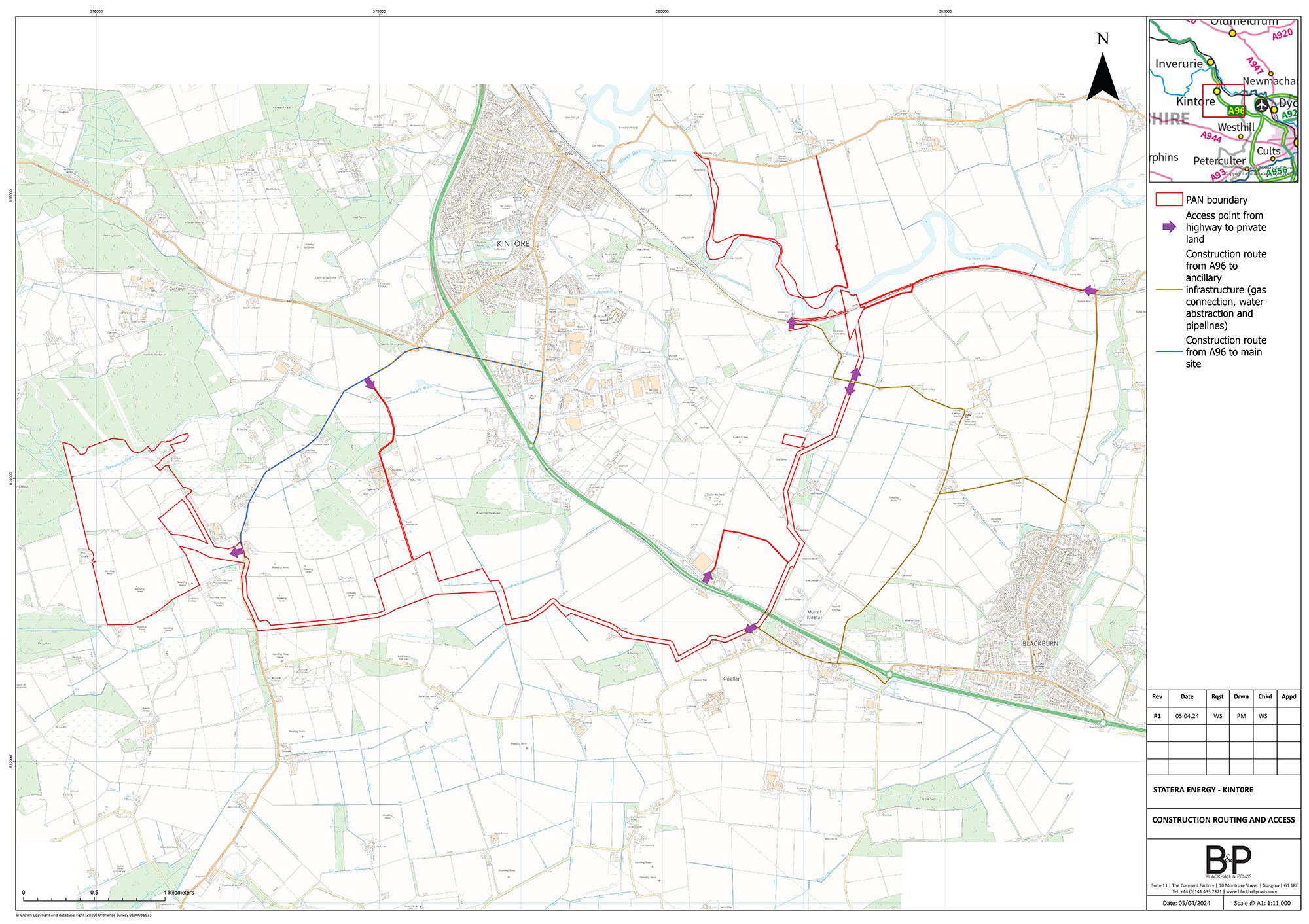
During operation
Between phases of construction and when no construction works are taking place, the construction access will not be used and the access will ultimately be removed upon completion of the development.
Operational access will be from a new access point at the southwest corner of the site (location B). Operational traffic is expected to be minimal given that workers will be predominantly transported to site via minibus with personal car use in the minority and minimised as far as practicable. Any other vehicles attending site would be for planned or ad hoc maintenance.
Additional accesses along existing farm tracks to the south (location C) and east (location D) of the site are available in the unlikely event that emergency services require access.
We will ask Aberdeenshire Council that the 40mph limit which currently ends as vehicles turn off the B977 is extended further west (approx. location E).
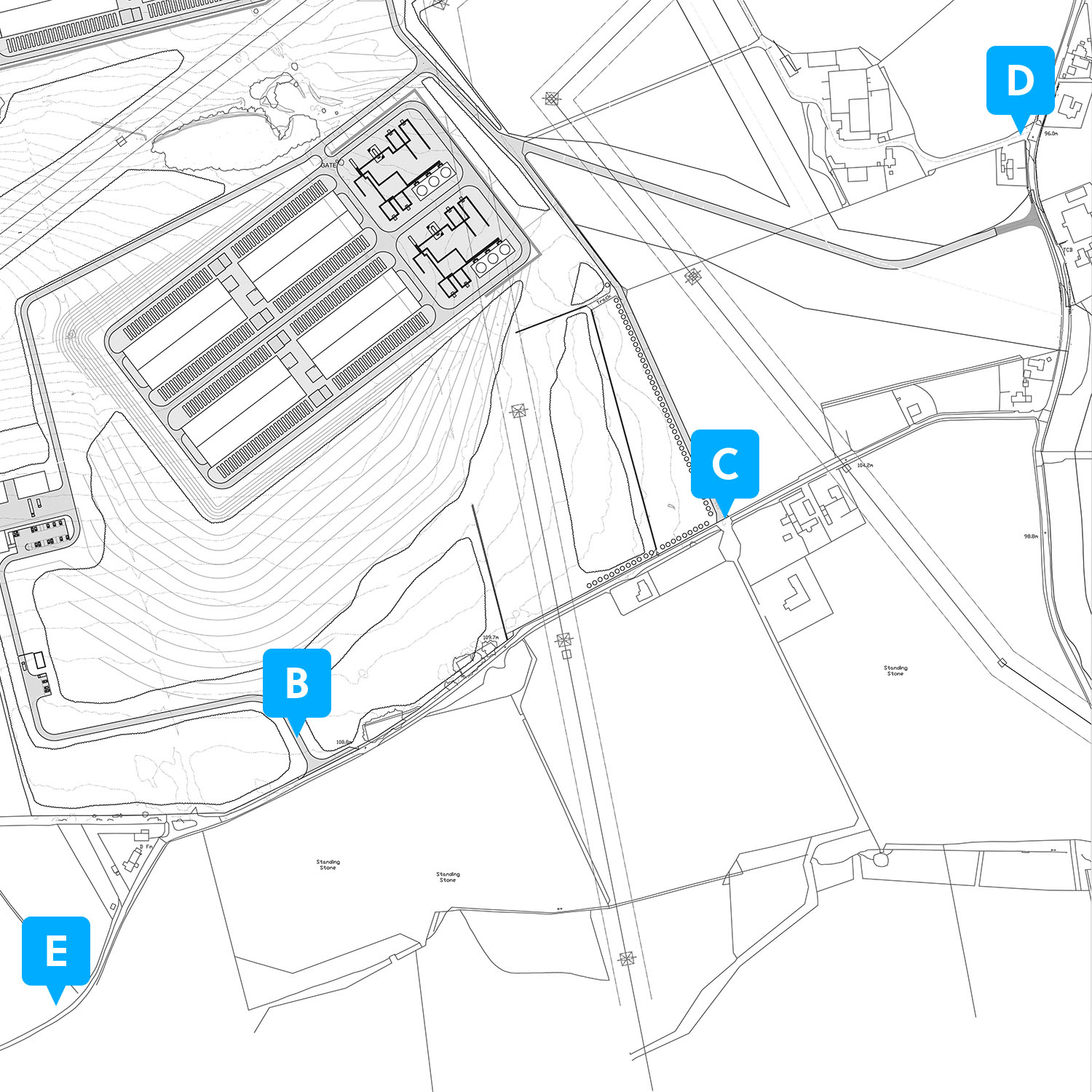

What is the planning process
There are different types of planning permission which can be granted by Aberdeenshire Council, in our case we will initially be seeking Planning Permission in Principle (PPiP).
What is PPiP?
PPiP is a type of planning consent that allows an application to be determined without full details on matters such as scheme layout, design or finish of any buildings, being secured or finalised. Whilst PPiP provides consent for a set of broad development parameters, the points of detail not yet addressed will need to be subsequently considered and assessed by Aberdeenshire Council before any development works can start for a particular phase.
For our scheme, we know the broad parameters of what will be needed to facilitate a functioning site but there are further details which are not yet known and will be refined in the future as the scheme design matures, including information on layout, landscaping, design or finish of buildings and environmental enhancements. Further applications for Matters Specified in Conditions (MSC) will be required to consent such detail. Multiple MSC applications will ultimately be required given that this is a phased development.
The first phase of development would therefore not commence until PPiP and any relevant MSCs have been approved by the Council.
Members of the public will be able to comment and submit representations at each stage of the planning process.
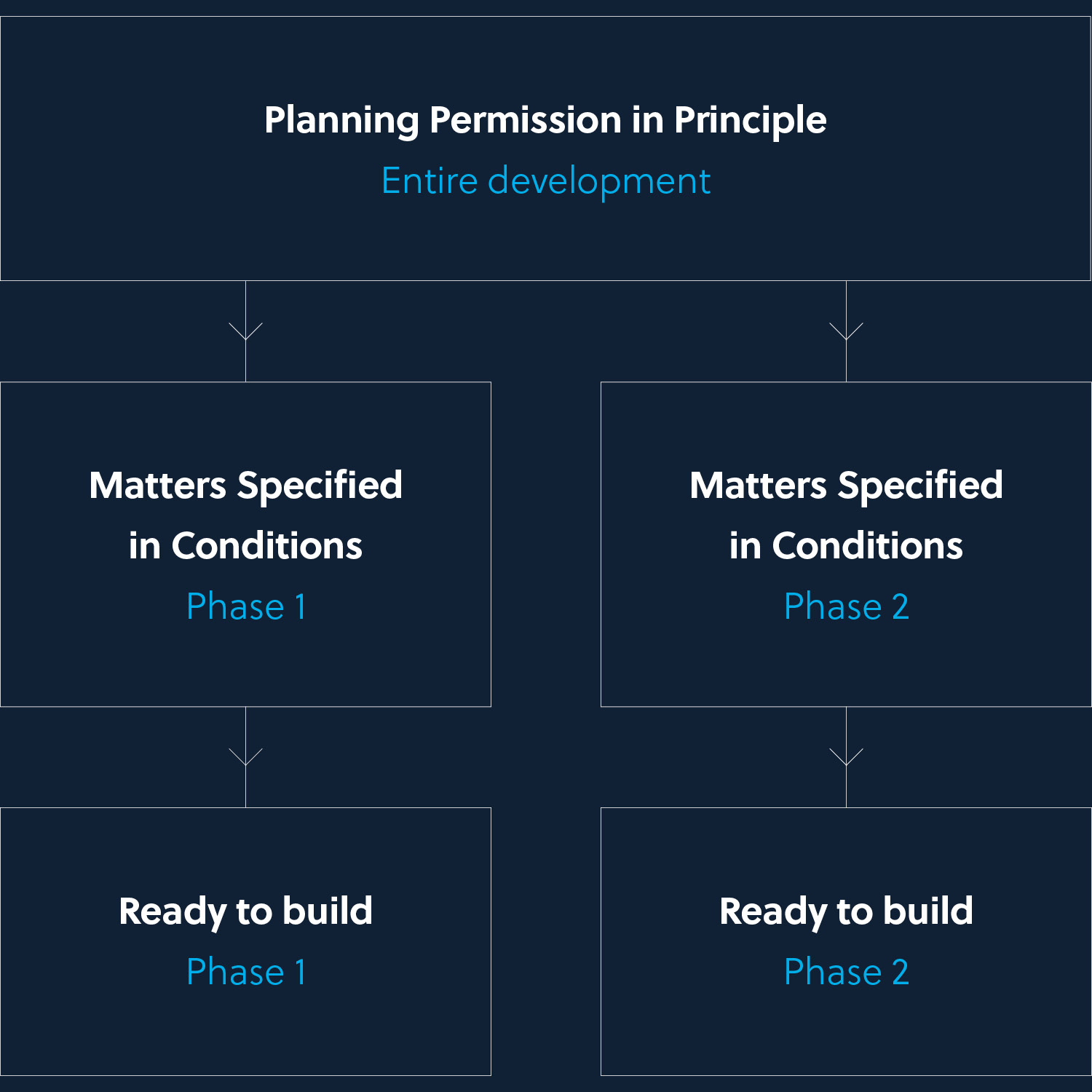
Further information
Further information on how planning applications to Aberdeenshire Council are managed is available online via the Council's website: https://www.aberdeenshire.gov.uk/planning/planning-applications/

*Where reference is made to a limit of deviation, this is an area in which the described plant is proposed to be sited. However, the actual footprint of the described plant in this area will likely be significantly smaller than the limit of deviation. The limit of deviation enables the flexibility for design that is necessary for phased development such as this for which planning permission in principle is being sought.

Benefits for local communities
01. Jobs
Kintore Hydrogen will require hundreds of highly skilled workers through construction and operation. The project will need construction and operational workers with a range of skills, such as engineers, fabricators, project managers and maintenance staff.
Aberdeenshire has a wealth of experienced workers in the energy sector as well as a growing workforce in renewables-led projects. Much of this knowledge, skills and experience is transferable to the construction and operation of a hydrogen plant. Kintore Hydrogen provides an opportunity for individuals to apply this expertise to a green hydrogen project as part of a Just Transition.
02. Training and reskilling
Kintore Hydrogen could create thousands of UK-based jobs in the construction phase and up to 200 operational jobs[1]. We are partnering with local education providers to ensure the region has the right skills and expertise to deliver this project: working with both new entrants to the workplace, like school leavers, as well as experienced workers.
We intend to set up training programmes, like apprenticeship schemes, with partners; if you are interested in working on our project please register your interest today.
[1]Based on independent modelling by the sustainability consultancy ERM
03. Opportunities for Aberdeenshire's businesses
The construction and operation of Kintore Hydrogen could provide substantial opportunities for local suppliers of materials and labour, and we are committed to working with local businesses to develop and run the project.
If you are part of a local business please register your interest with us today, so that we can keep you informed about opportunities related to the development of Kintore Hydrogen.
04. Community benefit fund
A community benefit fund is typically a pot of money made available by a developer which the local community can use to fund projects and initiatives of its choice, subject to meeting eligibility and other criteria. Government does not currently require developers of hydrogen production facilities to provide a community benefit fund. However, Statera wants to support the local community in directly benefiting from being neighbours to the proposed project.
In designing the community benefit fund we are thinking about its administration, the application process, and the sorts of things grants could be spent on. Longer term we believe this could be transformational for the local area and we want your feedback and ideas on the fund, so that it works well and is successful for local people. Please provide your views in the feedback form.





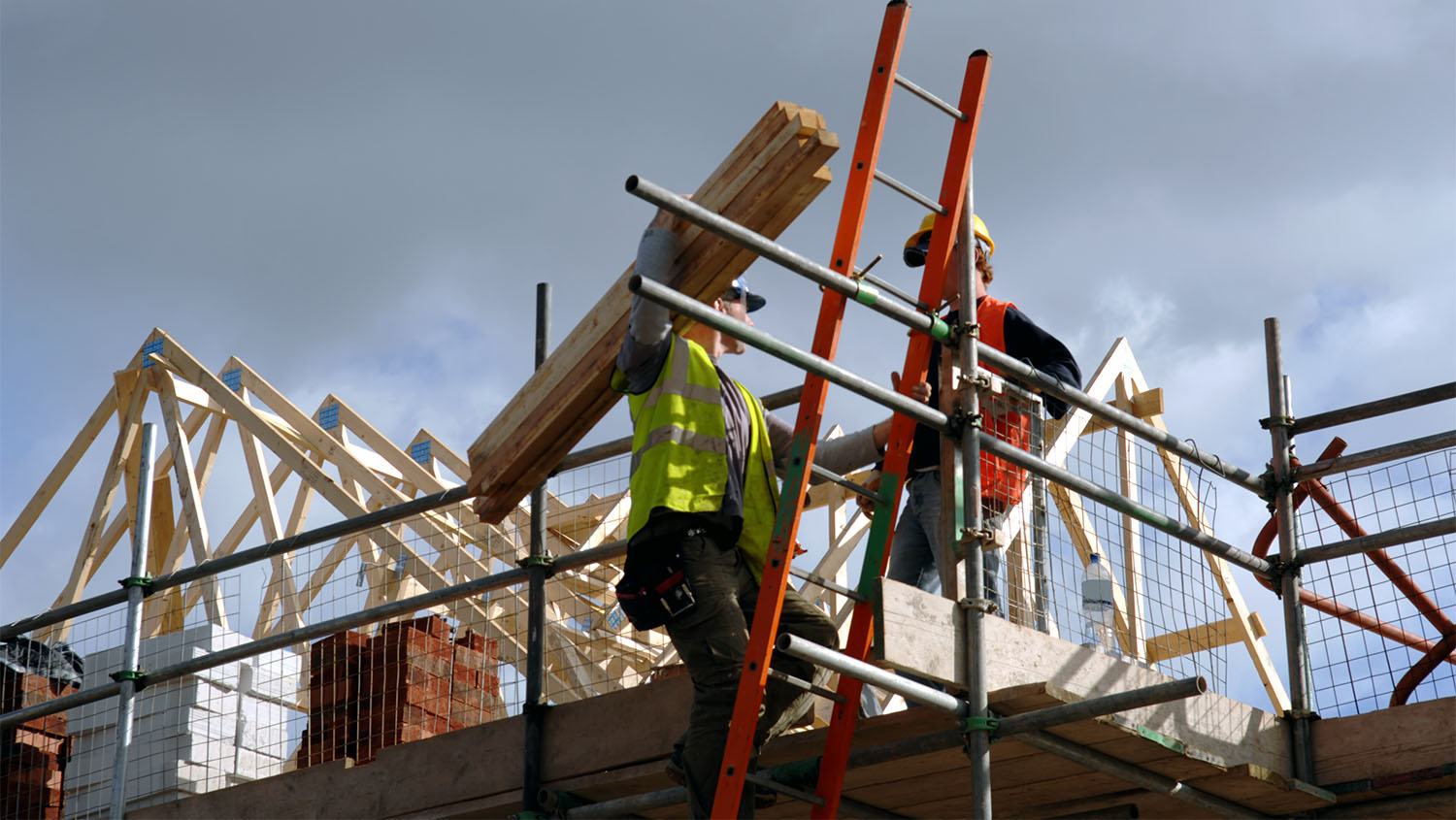

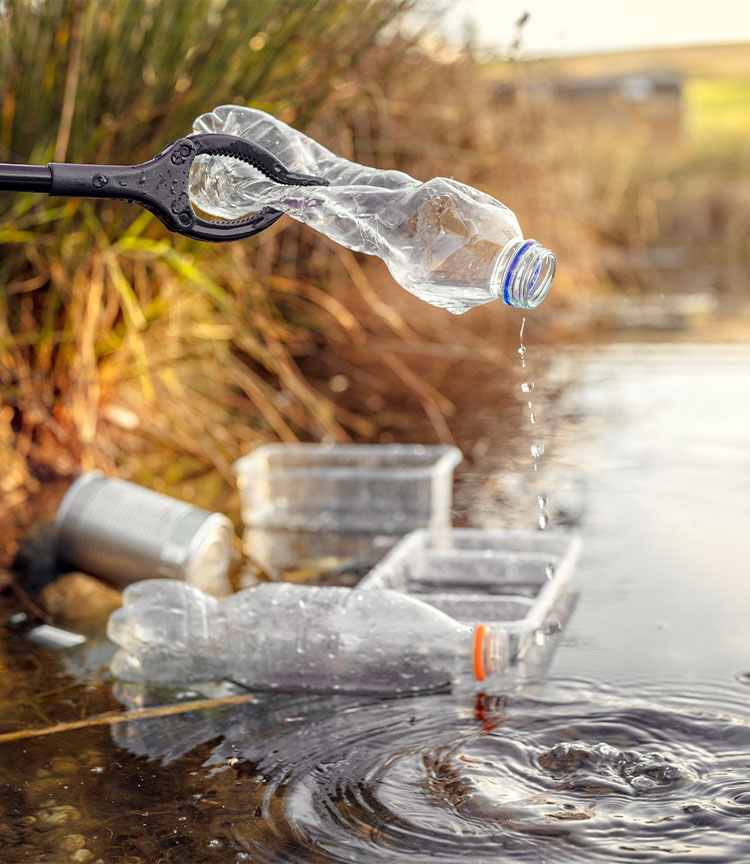



Feedback and consultation timeline
Thank you for viewing our public exhibition. Please take the time to provide feedback to let us know your views on the proposals and importantly provide any additional comments you may have.
Feedback
Next steps
We will take account of all comments received during our consultation and will prepare a Pre-Application Consultation (PAC) Report, which will summarise feedback received and, where possible, how this has informed the final proposals. This Report will be submitted as part of the PPiP planning application submitted to Aberdeenshire Council.
Opportunity for involvement
We welcome your comments on what you have seen and would be grateful if you could provide feedback. You can provide your views by completing our feedback form. Please note that feedback can be provided up until Friday 19th July 2024. If you have any further questions regarding any aspect of the proposals, please contact us via the details below:
Email: [email protected]
Post: Kintore Hydrogen, C/O Cavendish, 1 West Regent Street, Glasgow, G2 1RW
Phone: 0141 264 2831
Online: www.kintorehydrogen.co.uk/contact
Please note
Any comments made to the Kintore Hydrogen project team are not representations to the Planning Authority. If a planning application is subsequently submitted to Aberdeenshire Council, normal neighbour notification and publicity will be undertaken and the public will have the opportunity to make formal representations on that planning application at that time.
Timeline
UK Government Net Zero Hydrogen Fund Award
March 2023
Our Request for EIA Scoping Opinion Issued
September 2023
EIA Scoping Opinion Issued by Aberdeenshire Council
November 2023
Submission of Proposal of Application Notice (PoAN)
March 2024
First Round Consultation
April 2024
Second Round Consultation
June 2024
Planning Application Submission (Permission in Principle)
September 2024
Consideration of Planning Application (Aberdeenshire Council)
Q4 2024 - Q2 2025
Anticipated Planning Application Decision Date (Aberdeenshire Council)
Q2 2025
(If Application is Approved) Start Phase 1 Matters Specified by Condition (MSC) Planning Application Submissions
Q2 2025
Target Grant of Matters Specified by Condition for Phase 1
Q3 2025
Anticipated Phase 1 Construction Start Date
Q4 2025
Anticipated Phase 1 Start of Operations
Q4 2028

Your feedback: ideas, comments & queries from the first event
A number of themes came out of our first event in April. Below we have included additional information and proposals based on the feedback. We have also provided further explanations where we cannot accommodate some requests made.
Operational access
We have moved the operational access approx. 300m to the east and will ask the Council to extend the 40mph limit (that currently ends at the B977 turn off) further west along the unclassified road at the southern perimeter of the main site area.
Community benefit
You have put forward a range of ideas, including: (i) broadband and water networks for unserved communities; (ii) residential energy efficiency measures (e.g. insulation, double glazing, heat pumps etc.); (iii) walkway/cycleway works; (iv) flood/power outage resilience; (v) improved bus services. A clear theme in responses was ringfencing a large part of the pot for communities closer to the site.
Our fund could support these emerging ideas from the community. Some measures suggested would be harder to deliver - for example, it is not likely a community benefit fund could support the establishment of a distribution network for natural gas.
We would welcome further ideas on community benefit.
B977 traffic calming
There were requests for traffic calming measures (e.g. speed cameras) on the B977. The Council will only consider traffic calming measures in circumstances where the average speed limit exceeds the 40mph limit by “10% + 2mph” (i.e. 46mph). We have acquired survey data that shows average speeds between 38mph and 42.5mph. Unfortunately, the Council's policies do not support additional calming measures here. One tool we can use is for our construction vehicles to drive well below the speed limit when approaching the site; this would reduce average speed limits for other road users during construction.
Why can't you move the site to the brownfield land at Kirkwood Commercial Park?
This location is predominantly let to businesses. It is therefore not brownfield land, which needs to be vacant/unused to qualify as brownfield. Of the pockets of unused land, the largest is roughly 10 acres and has planning permission for an energy from waste plant, for which the developer is currently discharging pre-commencement planning conditions. Even if the park was entirely vacant, it would be too small for Kintore Hydrogen and would present a challenging 400kV electricity connection back to Kintore substation.
Is the site safe?
Safety of the plant is a central tenet of the ongoing Front-End Engineering and Design (FEED) process and will continue to be, through detailed design and beyond.
The operational plant is likely to be in the lower tier of the Control of Major Accident Hazards (COMAH) regime. Statera employees have significant COMAH site experience through previous roles (e.g., Rough gas storage; Grangemouth), which will be supplemented by further hires and internal procedures.
For a lower tier site, the Health and Safety Executive and SEPA will require the preparation of a major accident prevention policy (MAPP), detailing:
- organisation and personnel
- identification and evaluation of major hazards
- operational control
- management of change
- planning for emergencies
- monitoring, audit and review
While hydrogen production via electrolysis on this scale is pioneering, there are established practices for mitigating risks arising from hydrogen that will be incorporated into final design and operation of the plant.
Light, sight, smell and noise
Light - Light spill was a common concern. As part of our proposals, we intend to submit an outline Lighting Strategy that includes measures to minimise light effects as much as we can while ensuring safe construction and operation. This outline strategy would need to be incorporated into each phase of the development through Matters Specified in Condition applications.
Sight - We are committing to advanced planting (secured via planning conditions) in the southern half of the main site as part of our first phase (including native species such as Scots Pine as part of the mix) with the aim of the completed structures for later phases being substantially screened from view. Depending on the cooling system selected, water vapour may be visible during certain climatic conditions.
Smell - No perceptible odours as a result of the operational project are anticipated.
Noise - Some respondents expressed concerns around noise. Any noise effects arising from the plant would need to be mitigated to the satisfaction of both the Council and SEPA (e.g. adapting noise sources; enclosing plant).

Viewpoint one
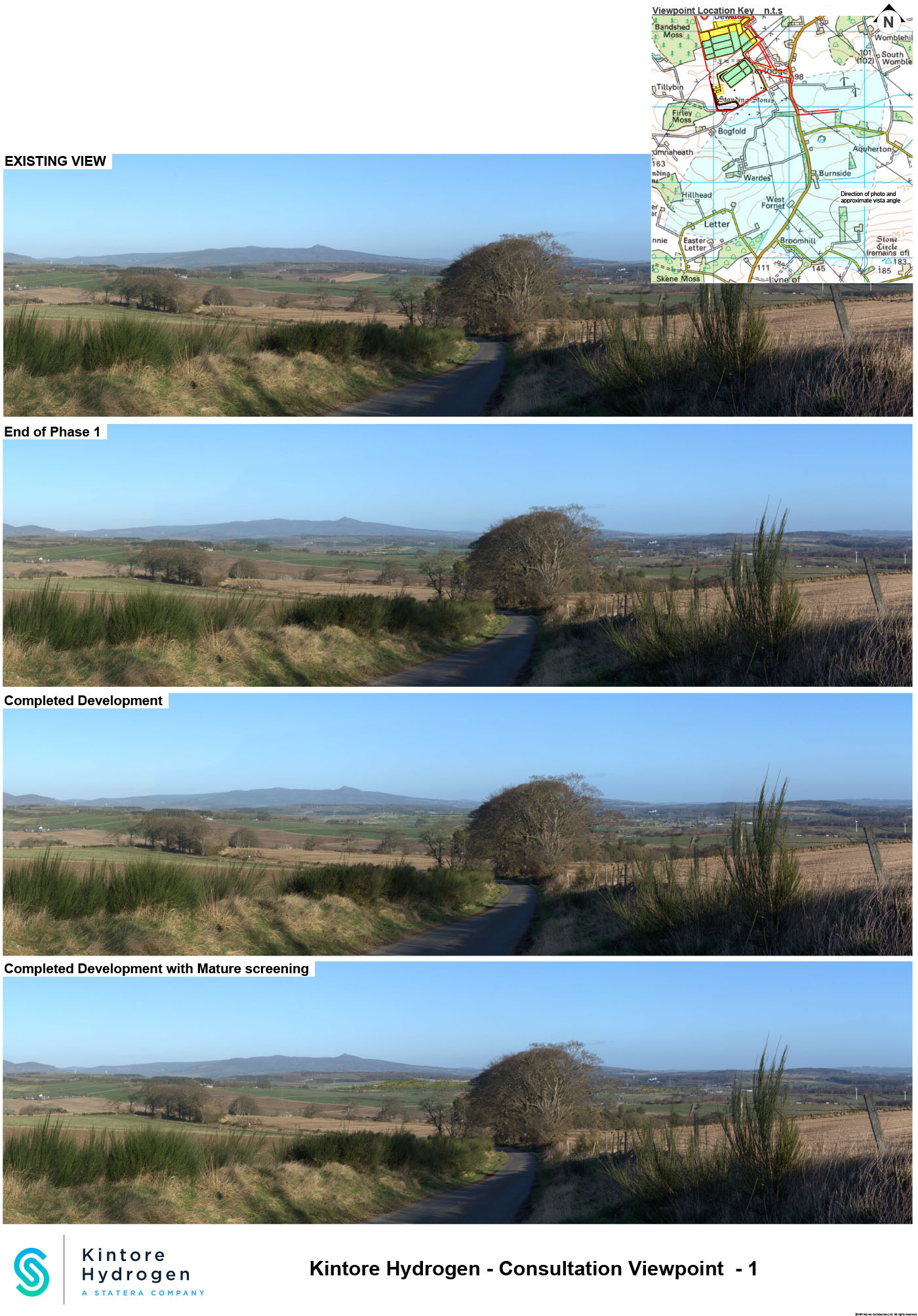

Viewpoint two
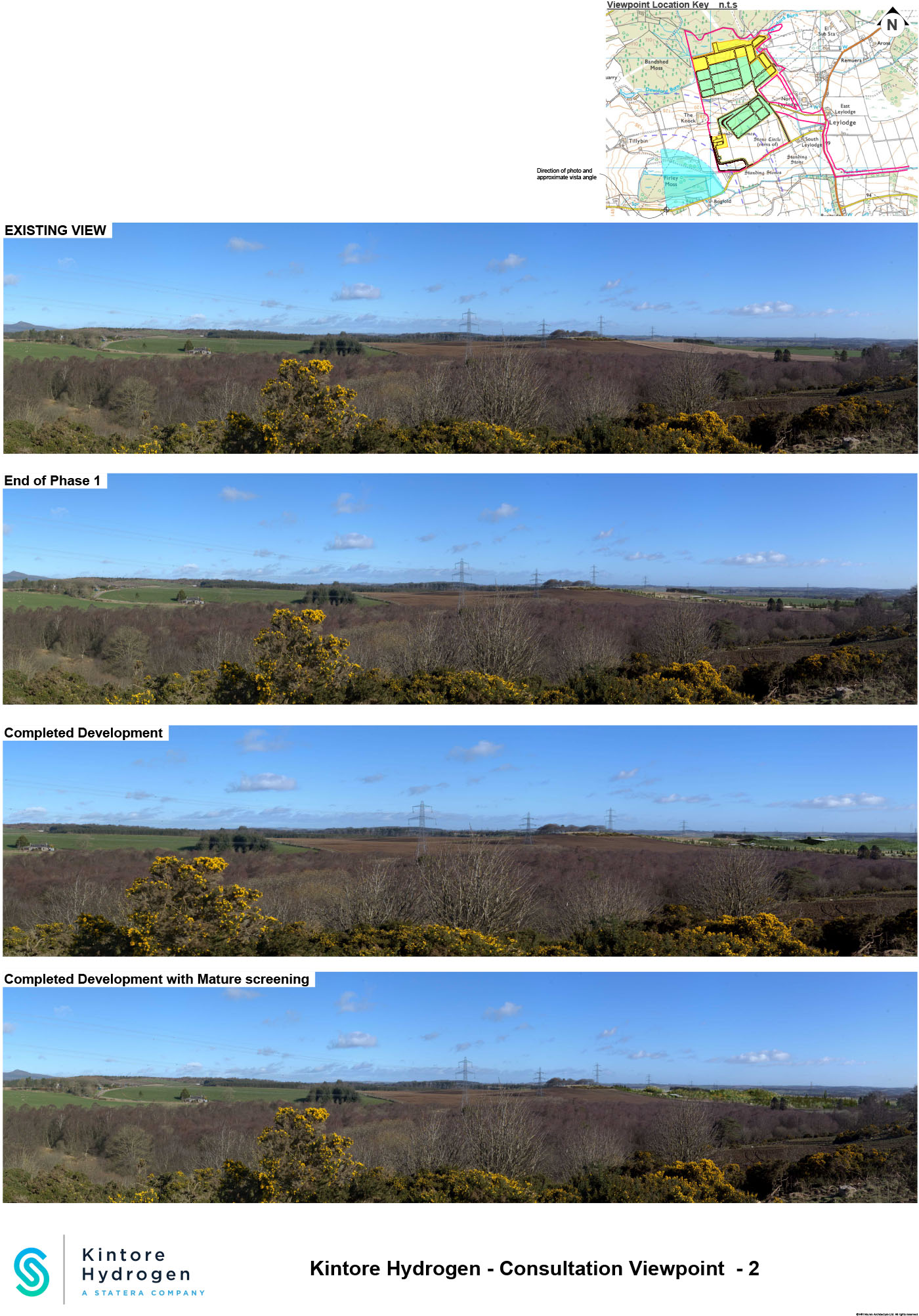

Viewpoint three
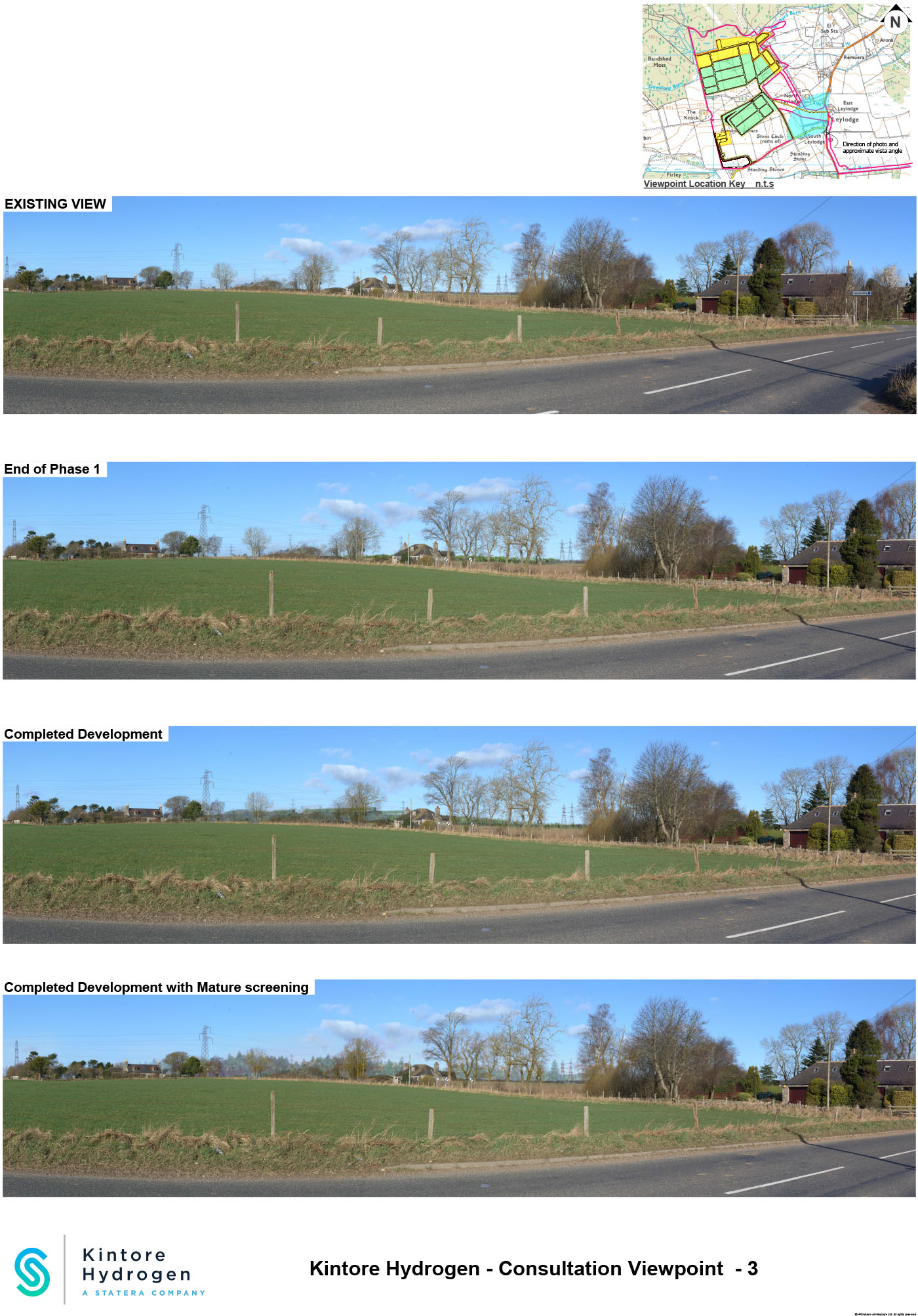

Viewpoint four
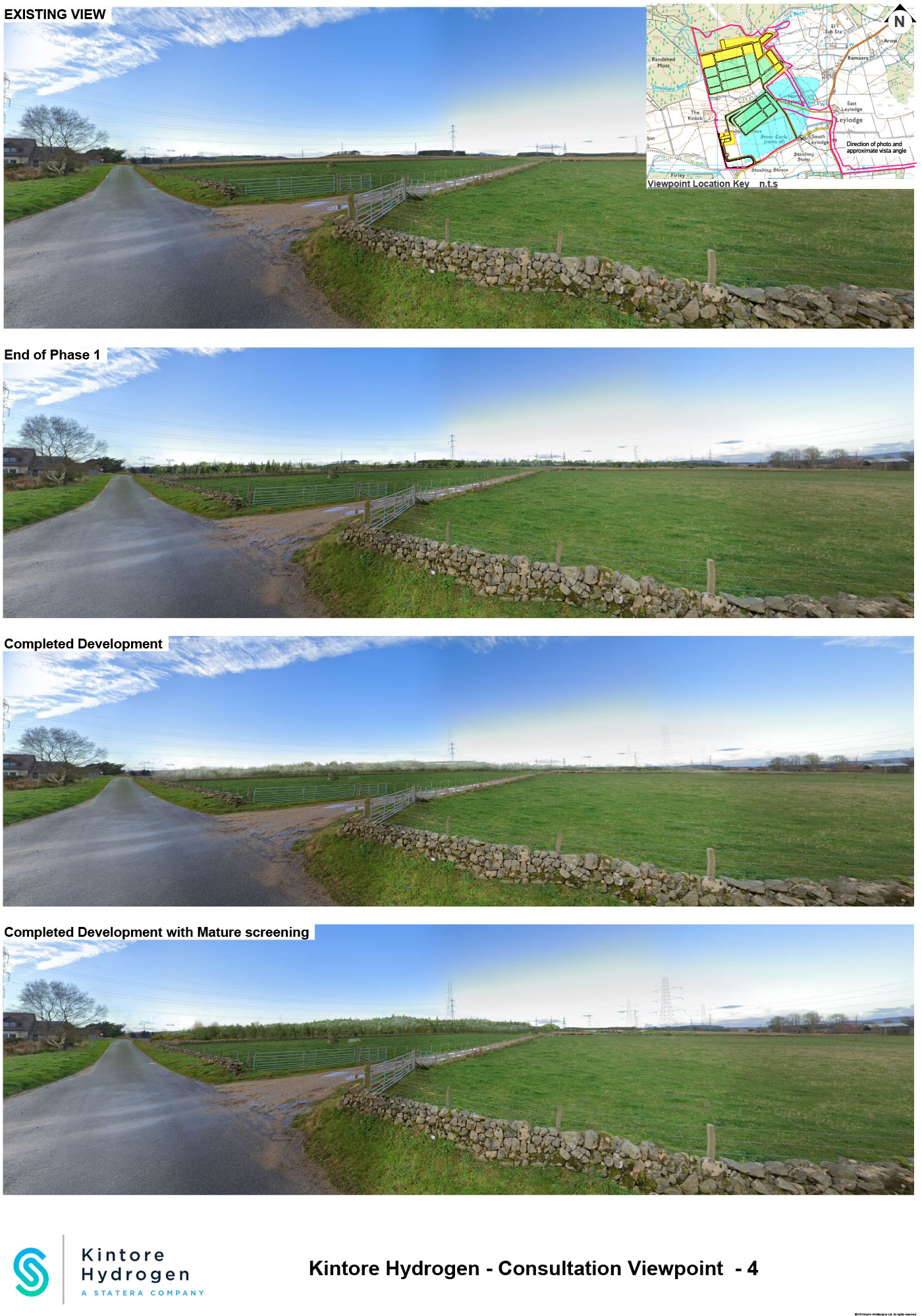

Viewpoint five
